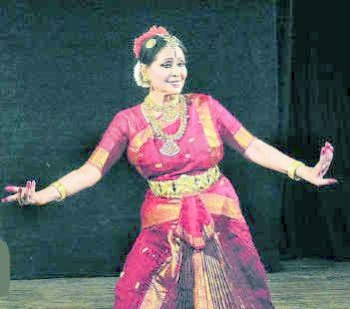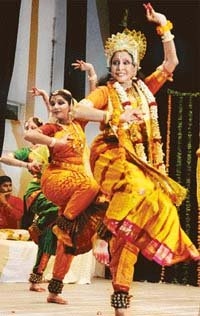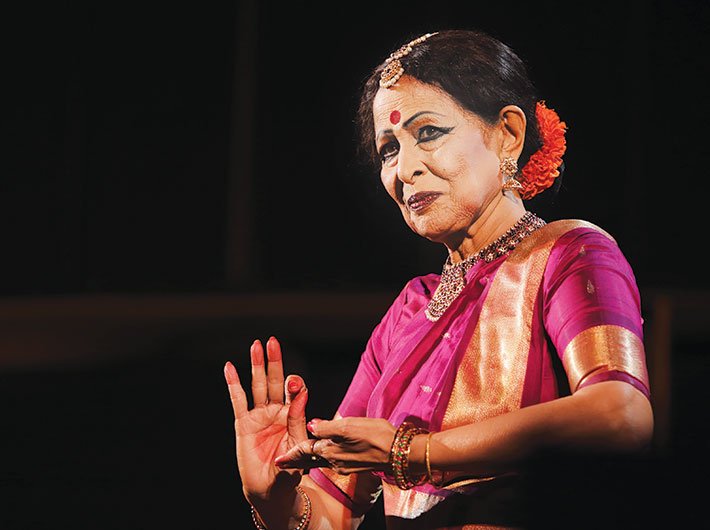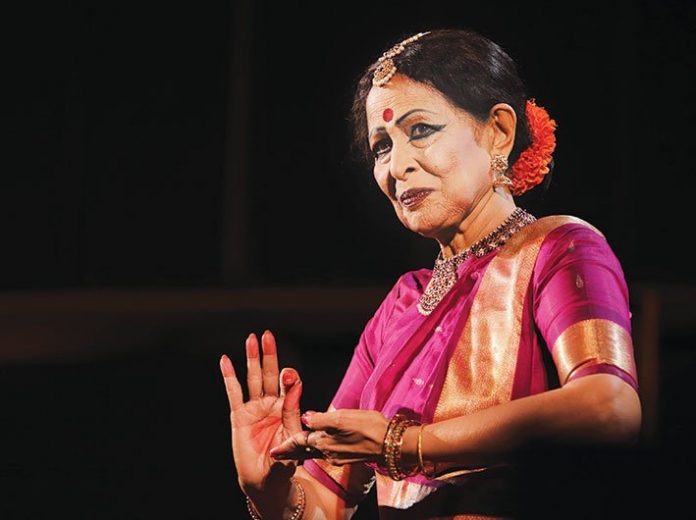Saroja Vaidyanathan

“…Married women, whether they agree or not with the old adage about a woman’s place being in the home, often do find that if they stay away from it for too long, the exalted edifice really does begin to fall apart at an alarming rate, literally and metaphorically. Round the world and down the ages, this situation has posed a challenge to women.
Some found the answer to this challenge in striking out on their own, dispensing with the props — and the bondage — of husband, children and extended family. Others, especially in India, found that they could use their tact, skills and time in such a way as to maintain their place behind the lace curtain, but at the same time make the outer world come inside. That this kind of compromise frequently takes place in India is not surprising, considering this is the land where the word ‘adjust’ has taken on mystical meanings.

Saroja Vaidyanathan, Bharata Natyam exponent and guru, author and founder of Ganesa Natyalaya, is one woman who found her destiny through this attitude of adjustment. At sixty-one, in the midst of the year-long Silver Jubilee celebrations of her institute, Guru Saroja tells her story with a disarming simplicity, devoid of rancour.
Married in her teens to an IAS officer posted in Bihar, the young Saroja, trained in Bharata Natyam by Guru Lalitha, a direct disciple of Kattumannar Muthukumaran Pillai, and in Carnatic music by the celebrated Professor P Sambamoorthy, suddenly found herself in an atmosphere where classical dance was derided as “Nautanki.”
“Why does your wife need to do Nautanki? What does she lack at home?” was the constant query of her husband’s concerned colleagues. Naturally enough, her husband could not remain unaffected, and persuaded her to stop dancing. So for some years Saroja fitted herself into the strait jacket of the ideal housewife. Of course this could not go on forever, and surely enough the obedient young wife was soon guardedly peeking out of her gilded nest for a glimpse of the sky. She wouldn’t dance, she assured her husband. But could she teach dance to children? Mr Vaidyanathan could not see anything scandalous about teaching children, and permission was easily granted.
Saroja Vaidyanathan got back in touch with the art she loved, and as she became known as a teacher, public opinion did an amusing about-face. “Why does your wife only teach dance?” was the refrain of anxious colleagues this time. “She should also perform!”
And so it was that Saroja Vaidyanathan began to give small performances at venues previously vetted and okayed as “decent,” such as the Rotary Club and other social gatherings. In later years she gave many performances in different parts of India and the world. But it was her natural aptitude for teaching that was destined to bring her into the limelight. Her husband’s transfer to the capital in 1972 was probably the healthiest thing that could have happened to her own career.
As students started trickling in to her classes at the spacious government quarters in central Delhi, a bolder dream than to merely be a dancer and teacher began to broaden her horizons. The seeds of a thriving institution, dedicated to the teaching and propagation of Bharata Natyam, were germinating in her fertile imagination. The Ganesa Natyalaya was officially established in 1974, but the ground reality of three disciples and a young teacher mocked at the grandiose dream.
Recalling the lack of encouragement on this front from her husband, she clarifies that his main concern was that his integrity as a highly placed government official should not be questioned. He felt his image would suffer if he supported her. On the other hand, he could not imagine his wife might be capable of carrying out the project by herself. It is not surprising therefore, that he discouraged her in perfectly good faith, and emphatically reminded her that any attempt to single handedly build up an entire institution, and that too in Delhi, was ridiculous.

“I am a very determined person,” she goes on genially, explaining how she got round the problem. Mr. Jagmohan, then Lt. Governor of Delhi, was known to the Vaidyanathans in his official as well as personal capacities. When Guru Saroja expressed the desire to acquire a plot of land in the Qutub Institutional Area (QIA) to construct a building for her institute, he gently persuaded Mr Vaidyanathan to let her try.
The Institutional Area was brand new then, and the price for the plot of land was only about a Lakh of rupees: cheap enough for someone who had the money, but a challenge for Saroja, whose husband told her she could expect no help whatsoever from him in raising funds. She set about collecting the money with the help of well wishers and sponsors. Pitching in with her personal savings, she managed to purchase the land in 1981. After this achievement, her husband was delighted to acknowledge her capabilities and thereafter extended his whole hearted support to her endeavours. The building was inaugurated in 1988.
In the interim, Guru Saroja continued with her performances and the evening classes at home. Early mornings found her at the site, sitting with the workers, overseeing the construction, and steadfastly praying that the empty and frightening wilderness in which she stood would one day resonate with the sound of music, dance and laughter.
Since the Natyalaya was one of the first institutions to move into its new premises in the QIA, it had no neighbours. The Founder President found herself lamenting to Mr Jagmohan, “How will we get students in the midst of this jungle!” But he assured her that the QIA would be a bustling and prime property soon enough, and of course he was right.
Today the road to Ganesa Natyalaya is lined with the huge boards and elegant gateways of renowned government and private institutions. Amidst the elaborate architecture of some of the other buildings, the simply designed Natyalaya presents almost a retiring look. There is no elegant reception area with gleaming brass lamps or ornate sculptures to greet visitors. But this is a place vibrant with constructive activity.
The rows and rows of footwear on the steps outside; the proud wooden boards inside displaying the names of the eighty students who have completed their arangetram so far, the walls of the classrooms adorned with large mirrors; and the scores of busy young people immersed in perfecting different aspects of their dance, all tell the story of the hard work and remarkable success of one immensely strong and dedicated individual.
On the paid staff of the Natyalaya are twelve dance teachers, mostly drawn from Guru Saroja’s own disciples, apart from teachers for Carnatic vocal music, mridangam, Tamil, and Hindi as well as a full-time receptionist. All the students are required to learn to sing their dance items once they reach the Jatiswaram stage. They also learn to recite their jatis and korvais with the tala. In addition they learn stotras, apart from the shlokas connected to dance. The Tamil teacher ensures that they understand in detail the meanings of the Tamil lyrics of their dance items. For seniors and other interested students
, she is available to take proper language classes. Similarly, the mridangam teacher imparts the basics of percussion to senior students. Students who are absorbed as dance teachers receive training in nattuvangam from their guru before taking up their duties.
With over a hundred students of varying capacities and ages on the regular roles and about fifty seniors who come from time to time for master classes, the administration of the institute is a mind boggling responsibility. Now that the teaching tasks are delegated between so many, Guru Saroja revels in the role of chief administrator.
Some of her students are holders of scholarships from the Indian Council for Cultural Relations (ICCR) or from the Council for Cultural Resources and Training (CCRT). These come to the Natyalaya daily at ten in the morning and stay till six in the evening. During these eight hours they receive intensive training in Bharata Natyam along with related subjects. Hindi is a compulsory subject in the case of overseas students.
Part-time students receive two classes a week. These include school and college going children, who come during the afternoons, and adults who prefer morning sessions or weekends only. Apart from personally teaching the seniors and scholarship holders, Guru Saroja ensures the standard of the junior classes by conducting regular “spot checks.”
Two large bookshelves of reference books stand in the office. All the dance dramas choreographed so far, as well as major performances by the troupe have been documented in a video library. Every year, she makes professional music recordings of the Bharata Natyam items choreographed by her. Copies of this music are available to students on payment of a nominal fee when required. The video, music and reading libraries are looked after by student helpers who are paid a token remuneration for their services to the Natyalaya. Similarly, the costumes, jewelry and photographs are looked after by students made mature by their guru’s trust in them. The Natyalaya is an impressive example of decentralization not many institutions could boast of..
Guru Saroja is a prolific choreographer, with ten full length ballets and “around two thousand” individual Bharata Natyam items to her credit. Imaginative and lively choreography ensure that the performances of her troupe meet with popular appreciation in India as well as other countries. She makes it a point to pay her students for participating in performances of the Natyalaya, thus inculcating in them a sense of responsibility and pride in their work.
Today her students are known for their taut lines, confident technique and charming stage presence. If this was not the norm two decades ago, it is a measure of the multi-dimensional growth of the guru who has kept an open mind and blossomed along with her institution. To create such a large pool of competent Bharata Natyam dancers in Delhi is no mean achievement, as any teacher of the art will admit. Students of other gurus have also opted at times to train with Saroja Vaidyanathan for higher studies, bearing testimony not only to the success of her teaching skills but also the gentle temperament that endears her to everyone.
Saroja Vaidyanathan stands out in several ways from many other artists. She is so dignified that she actually relinquished the flat in the Asiad Village complex allotted to her under the artists’ quota by the government when, after her husband’s retirement, they decided to move to the tiny residential space in the Natyalaya premises in order to be closer to the work.
Though Saroja Vaidyanathan does not indulge in irrelevant or harmful gossip, she has had her share of brickbats, and cannot help voicing her offense at the whispers that success came easily to her because she was the wife of a high government official. Since deeds speak louder than words, she can afford to ignore any unfair criticism. Instead, she can be proud that she learnt her administrative lessons well. Though her husband is no longer by her side she is in complete command of the multiple activities of the institute.
If she has been criticized she has been amply recognized too. The Sahitya Kala Parishad Award, the titles of Natya Tilakam and Natya Kala Bhushani, and the latest among them, the prestigious Kalaimamani award of Tamil Nadu are some of the honours that have come her way.
As the Ganesa Natyalaya goes into its twenty-sixth year, its members and the ordinary citizens can be grateful that the wilderness became an orchard, and that the air is full of the sounds of song and dance, of laughter and prayer.”


